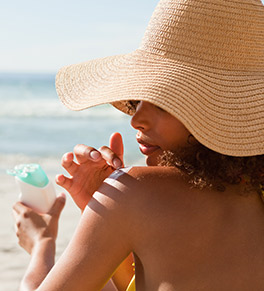Choosing a sunscreen: Stick or lotion?

"For the average user who applies stick sunscreens using just a few passes, it is unlikely they will get full coverage compared to a liquid sunscreen," says UCI Health dermatologist Dr. Natasha Mesinkovska.
Sunscreen solid sticks are convenient. You just glide the product on your skin, pop the cap back on the tube and go.
You needn't rub in lotion or clean goop from your hands. Nor do you have to worry about the contents spilling over everything inside your beach bag or backpack.
Moreover, most quality solid sunscreen sticks with a high sun protection factor (SPF) contain the same protective ingredients to shield the skin against damaging ultraviolet rays as the best lotions.
But are they as effective? Maybe not.
The problem, says UCI Health dermatologist Natasha A. Mesinkovska, MD, PhD, is making sure you've applied enough. The recommended amount is about 2 milligrams per square centimeter of skin, or a little more than a quarter-teaspoon per square inch.
Hard to measure
"While this amount is fairly easy to estimate and visualize using liquid sunscreens, it can be difficult when using a stick sunscreen," Mesinkovska tells Well+Good, an online health-and-wellness publication.
"Because of this, most users will not get the recommended coverage using a stick sunscreen, even with multiple passes or layers over the face to achieve full SPF coverage," adds Mesinkovska, who specializes in the diagnosis and treatment of skin disorders, including skin cancer, hair loss and dermatitis.
"For the average user who applies stick sunscreens using just a few passes, it is unlikely they will get full coverage compared to a liquid sunscreen."
Convenience vs. comfort
Solid sunscreens are formulated with waxes and gel agents. To get enough coverage, "be prepared to feel a thick layer of sunscreen on your face," warns the skin specialist, who also serves as an associate professor of dermatology in the UCI School of Medicine and vice chair for clinical research for the Department of Dermatology.
"It will most likely not be as comfortable and practical for daily use as liquid sunscreens."
That said, Mesinkovska acknowledges their appeal: They are spill-proof, mostly mess free and very convenient to reapply throughout the day.
Convenience is, after all, important. As she points out, the best sunscreen of all is the one people actually use!
Related stories
Explore further
Browse more blog posts by topic.




